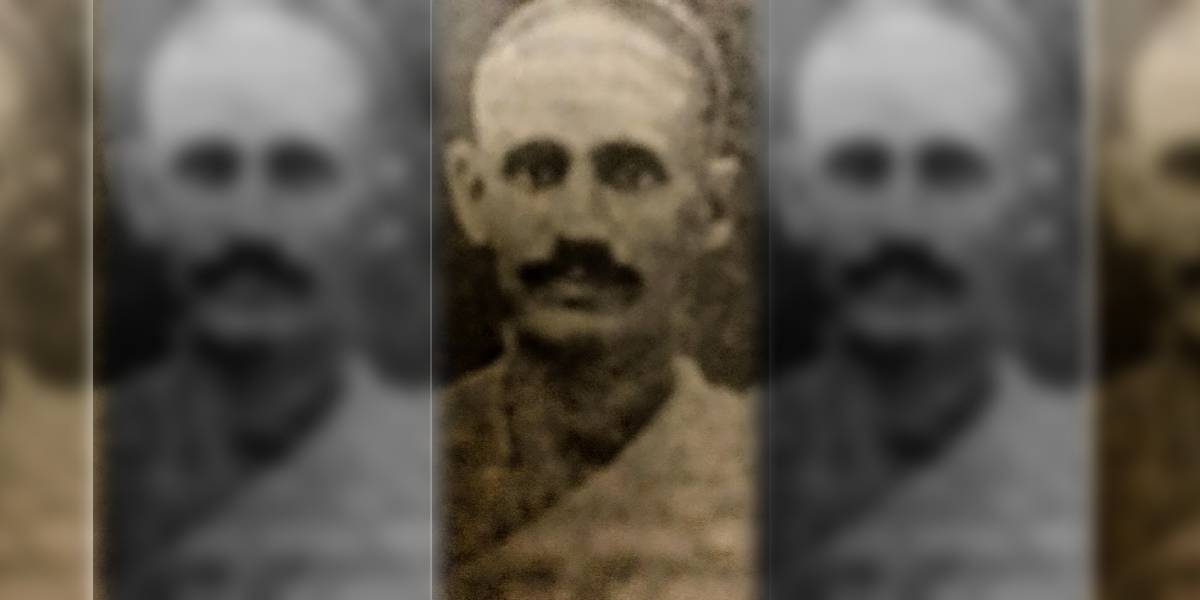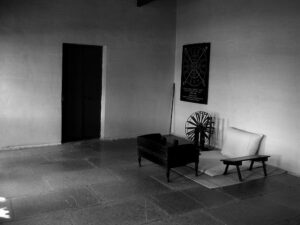He devoted himself completely to the Mahatma's Swadeshi and Independence movements. Drawn to the teachings of Basavanna, Manjappa propagated his philosophy of 'Kaayakave Kailasa' (work is worship) through his speeches and writing.

Hardekar Manjappa (Kannada Vishaya Vishwa Lodha)
Gandhi and Gandhism (a body of ideas used to describe the inspiration, vision, and mission of the Mahatma) seem nowadays to have lost their relevance. Gandhi — the apostle of truth, non-violence, and tolerance — has almost been forgotten.
When Mahatma Gandhi is remembered — on his birthday and the anniversary of his death — it is more ceremoniously than sincerely. But the truth is that Gandhi and Gandhism may be more relevant than ever in an India that is increasingly fracturing along religious lines and in thrall to politicians keen to pit peoples and communities against one another.
It is in this context that Hardekar Manjappa, fondly called the Gandhi of Karnataka, assumes importance. He was a staunch Gandhian who lived, ate, spun, taught and wrote as per the Mahatma’s ideals and who devoted himself completely to the Swadeshi and the Indian Independence movements.
Hardekar Manjappa was born on 18 February 1886 and today is the 137th anniversary of his birth. After giving his all to his country and the Kannada people, he passed away on 3 January 1947, just seven months before India achieved Independence.
In his early days, Hardekar Manjappa, who was born in Banavasi and became a school teacher in Sirsi, was greatly influenced by Bal Gangadhar Tilak, one of the tallest leaders of the Indian Independence movement in the early 1900s and well known for his declaration: “Swaraj is my birthright and I shall have it.”
Later on, Manjappa would come in contact with Gandhi and become a follower. He would go on to write in Kannada about Gandhi and his grand ideals of non-violence, religious tolerance, and Sarvodaya.
Inspired by Gandhi’s teaching, Manjappa decided a life of celibacy was the best way to serve society. A torchbearer of Gandhian ideals and a firm believer in Gandhi’s principle of ahimsa or non-violence, he chose to educate the people of Karnataka on the need to use non-violent means to achieve Independence. He contributed his might to the success of the Belgaum session of the Indian National Congress by giving a talk in Kannada on the importance of the non-violent way of resistance.
He visited Gandhiji’s Sabarmati Ashram and spent time there to experience the life of a satyagrahi.

Mahatma Gandhi’s visitor room at Sabarmati Ashram (Wikimedia Commons)
Later, in 1923, Manjappa developed a Satyagraha Ashrama near the village of Harihara on the banks of the Tungabhadra and started an Ashram School in Almatti. He also published Mahatma Gandhi Charitre (A History of Mahatma Gandhi’s Life) and Satyagraha Dharma (The Dharma of Satyagraha) in Kannada.
Drawn to the teachings of Basavanna, the famous 12th-century saint, social reformer, and vachanakaara (composer of vachanas), Hardekar Manjappa propagated Basava’s philosophy of Kaayakave Kailasa (work is worship) through his speeches and his writing.
During his lifetime, he published over 20 works, many of them devoted to the explication of Basava’s philosophy. His published works include Swakartavya Siddhaanta, Basava Charitre, Basava Bhodaamruta, and Vachanakaarara Samaaja Rachane. In 1931, he also started Sharana Sandesha, a weekly magazine that espoused Basavanna’s ideals.
Manjappa can correctly be called a political thinker, social reformer and independent journalist. In September 1906, he launched his first newspaper Dhanurdhaari, in which he published Kannada translations of the articles written by Tilak in the Marathi journal, Kesari.
For the propagation of the Khadi movement, Manjappa, the Gandhi of Karnataka, launched Khadi Vijaya, whose focus was self-reliance.
“Despite being an ardent follower of Gandhi, Manjappa did not simply accept everything Gandhiji said. For instance, he refused to associate with the Congress. However, through his writings, Manjappa encouraged people to support the Congress in its fight for India’s freedom,” says Halappa GS, a former lecturer in the Department of Political Science, Karnatak University, Dharwad, in his article published in Kannada Vishaya Vishwakosha brought out by the University of Mysore.
In his article, Halappa observes that “Hardekar Manjappa fought for the empowerment of women in every stream of life and published Stree Neeti, a guide for the empowerment of women”.
Manjappa was born in 1886, a time when the freedom movement was taking hold all over the country. With the help of his brother, who was working as a clerk in Sirsi, Manjappa passed the Mulki exam (the equivalent of today’s 7th-grade final exam) and became a teacher in the same school for a monthly salary of ₹7.50.
A couple of years later, Manjappa was promoted and made a teacher in an independent school. According to Prof R Rachappa (who wrote a long article about Hardekar Manjappa in Saalu Deepagalu, a publication of the Karnataka Sahitya Academy), Manjappa, apparently, was very keen to master Sanskrit.
“Manjappa’s wish was that people refer to him as ‘Shastry’. He wrote a poem on the need of using Swadeshi things using the pseudonym Manjunatha ‘Shastry’. ‘A poem of mine was published in Mysore Star journal and, just like that, I became Shastry’ is an incident Manjappa refers to in his memoirs. This is evidence that Manjappa never fulfilled his dream of mastering Sanskrit,” says Rachappa.
The Independence movement was picking up at the time Hardekar Manjappa became a schoolteacher and he was not content to just sit by and watch.
Determined to participate in this historic movement, “[Manjappa] resigned his job and launched Dhanurdhaari with the support of his brother. They made Davanagere their publishing centre. While Manjappa edited the journal, his brother took care of the journal’s distribution and marketing. As Manjappa was translating articles published in Kesari on the freedom struggle, Dhanurdhaari became popular and earned over 700 subscribers”, writes Prof Rachappa.
Noting the increasingly fierce nationalism of the journal, the printer who they depended on increased their rent, forcing them to shut down. Not to be deterred, the brothers began a new journal called Sacchidaananda in 1908.
However, the constant targeting of their editorials by government officials was responsible for blunting Manjappa’s pen, making the journal lose its force and subscribers. Despite this, Manjappa’s editorials remain historically important and display his understanding of the historical, political, economic, and social issues of the time.
Hardekar Manjappa opted to write and publish books to educate people. His published works can be classified under categories such as nationalist writings, research, linguistic issues, societal refinement, journalism, and children’s literature.
“A look at the works of Manjappa shows that he never wrote to prove he was a writer. He wrote to express himself and to share his ideas with the people around him,” observes Prof Rachappa.
Evaluating Manjappa’s works, Prof Rachappa believes Manjappa deserves to be recognised as the doyen of the streams of Vichaara Saahitya (Intellectual Literature) and Raashtreeya Saahitya (Nationalistic Literature) in Kannada.
The printing of seven editions and the sale of more than 15,000 copies of Buddhi Maatu (Words of Wisdom) between 1915 and 1925 stands as a remarkable testament to the popularity of Manjappa’s prose as well as his intellect. “Readers who read Manjappa’s biography will be struck by his poetic vision, critical outlook, and comparative approaches”, notes Prof Rachappa.
Manjappa’s Basava Bodhaamrutha has been translated into Marathi and his Vachanakaarara Samaaja Rachane was translated by Prof Bodade Swami Rao into English.
Some of his smaller booklets have been translated into Urdu and Hindi. Manjappa, whose only official qualification was passing the Mulki examination, would go on to become one of the great prose stylists of 20th-century Kannada literature. (He also wrote in English, Sanskrit and Marathi.)
“The popularity of Manjappa’s prose lies in its direct simplicity,” concludes Prof Rachappa, a scholar who has undertaken a detailed study of his works.
For his significance in the freedom movement in Karnataka, for his creation of a body of simple yet effective literature, for his journalistic courage, for his adherence to the principles of his two greatest idols, Basavanna and Gandhi, and, most of all, for following the famous dictum of nudidante nade (Do as you say), Hardekar Manjappa remains a man not simply to be remembered but emulated, by both Karnataka and India.

Apr 16, 2024

Apr 16, 2024

Apr 16, 2024

Apr 14, 2024

Apr 13, 2024